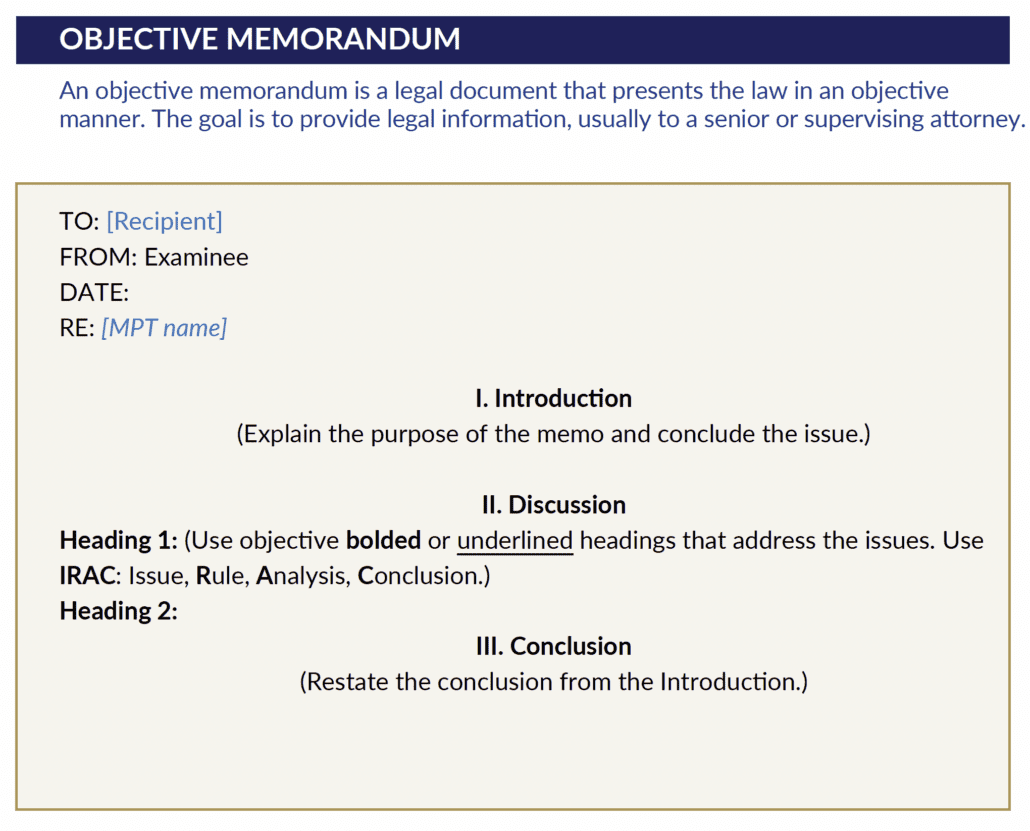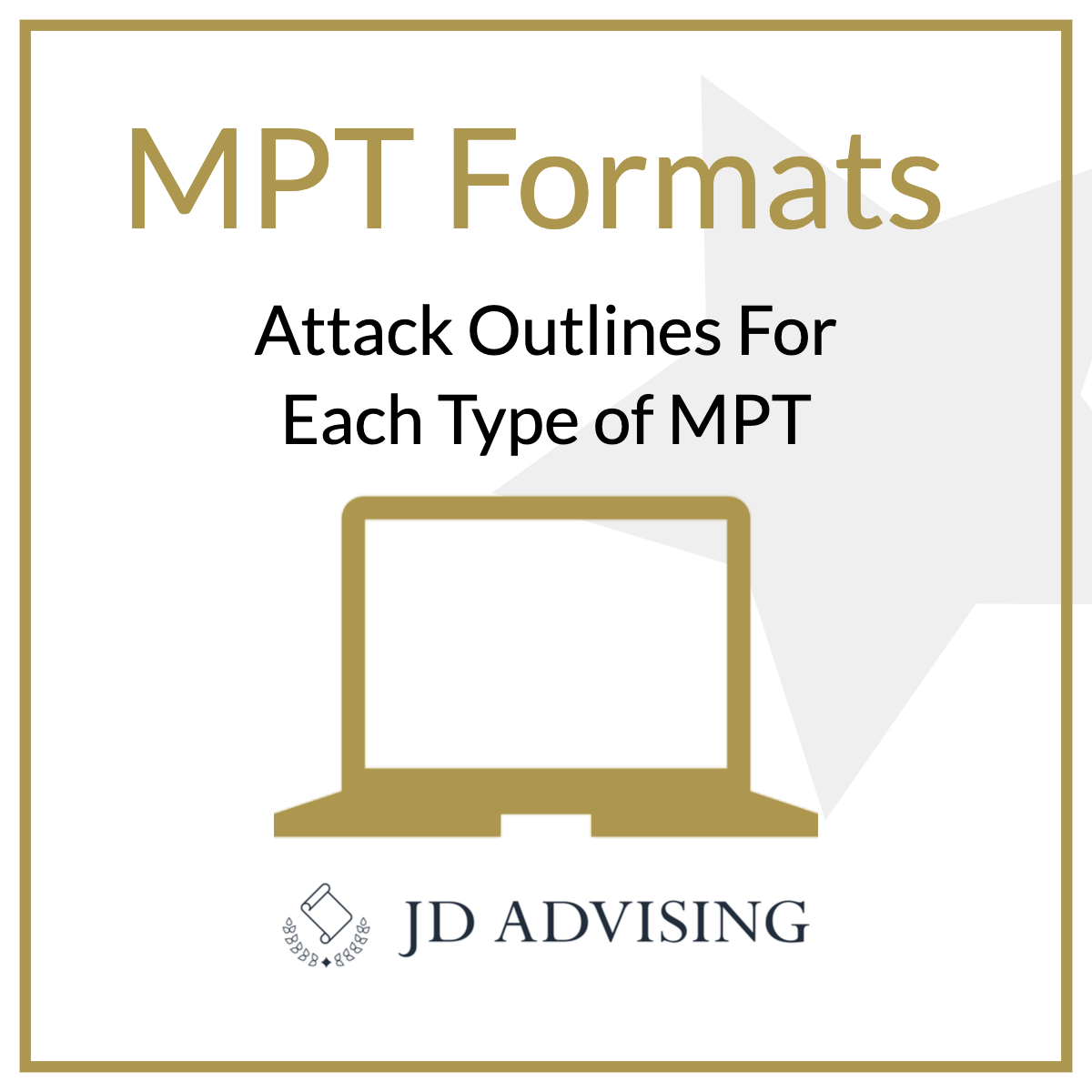How to Format an Objective Memorandum on the MPT
How to Format an Objective Memorandum on the MPT: Are you wondering how to format an objective memorandum on the MPT? It can seem unnatural at first — it is probably different than what you learned in your legal writing class!. However, once you get the hang of it, you will have no problem learning how to format an objective memorandum on the MPT.Essentially, the bare-bones format of an objective Memorandum is as follows:
Introduction
Discussion
Heading
Heading
Heading
Heading Conclusion

You can see this in more detail below when the following objective memorandum, based upon the February 2015 MPT In re Harrison. We give you a detailed description of what to include — and not include — in an objective memorandum. We also then show you the same memorandum without the instructions (so that you can have a nice birds-eye view of what it looks like!)
MEMORANDUM
To: Esther Barbour
From: Examinee
Date: September 22, 2016
Re: Daniel Harrison matter
Introduction
Generally, the first paragraph should be a short introduction that states the task you have been asked to complete. Include the relevant legal authorities. It is a good idea to write the introduction last – only then will you have solid understanding of the issues.
Example of an introductory paragraph:
You have asked me to analyze the inverse condemnation theories that Daniel Harrison may use to bring a claim against the City of Abbeville. Under federal law, three theories are available to Harrison: 1) a total regulatory taking, 2) a partial regulatory taking, and 3) a land-use exaction. Additionally, Harrison might be able to pursue a claim under the substantial advancement test under Franklin law, depending whether this test is still valid under the Franklin state constitution. Newpark Ltd. v. City of Plymouth (Franklin Ct. of App. 2007). Because your memorandum states that no physical taking has occurred, this theory will not be addressed below.
Do not include a statement of facts unless the task memo instructs you to do so. If you are told to include a statement of facts, that should be your next section. The statement of facts should be no longer than six or seven sentences. Use the facts in the task memo as a jumping off point.
Discussion Section
Then write the discussion section of the objective memorandum. Each issue should have a heading that applies the law to the facts and states a conclusion. Use the directions in the task memo to help you determine which issues to address.
Here we have four inverse condemnation theories to analyze, so it is best to examine each theory separately. If any of the legal theories have several elements to analyze, create subheadings for each element (see partial regulatory taking below).
Headings
Examples of headings:
- Harrison likely does not have a claim based on the total regulatory taking theory because the City’s regulation has not deprived Harrison’s property of all of its economic value.
- Harrison will likely succeed based on a partial regulatory taking theory because the City’s regulation reduced the value of his property to a few hundred dollars and interfered with his reasonable expectations of using the land for a truck-driving training facility.
- Economic Impact of the Regulation
- Interference with Reasonable Investment-Backed Expectations
- Character of the Governmental Action
- Harrison is unlikely to succeed on a claim based on the land-use exaction theory because the City Council did not offer to condition the approval of his rezoning application based upon requiring him to take some action.
- Harrison likely does not have a claim based on the substantial advancement theory because the denial of Harrison’s rezoning application “substantially advances” the legitimate state interest of protecting public health and safety.
Under each of the headings, state the relevant rule of law that you extracted from the library and apply the facts from the file to those rules. Even though there are four legal theories to discuss, each theory will not be analyzed in the same amount of detail. Look to the cases to determine how detailed your discussion should be and allocate your time accordingly.
Conclusion
The last section of the objective memorandum is the conclusion. The conclusion should summarize your discussion and reinforce the conclusions you made above. The conclusion does not need be longer than three or four sentences. Proofread your conclusion to ensure that it is consistent with what you wrote earlier in your memo.
Example of a conclusion:
Harrison has the greatest chance of success against the City of Abbeville if he bases his inverse condemnation claim on the partial regulatory taking theory. He is unlikely to succeed if he pursues a claim based on the total regulatory taking theory or the land-use exaction theory. Even if the substantial advancement theory remains valid under Franklin law, Harrison is unlikely to succeed.
If you take out all of the “fluff” (the blue instructions) it looks simpler than it may look above — you can see it follows a very clear format!
MEMORANDUM
To: Esther Barbour
From: Examinee
Date: September 22, 2016
Re: Daniel Harrison matter
Introduction
You have asked me to analyze the inverse condemnation theories that Daniel Harrison may use to bring a claim against the City of Abbeville. Under federal law, three theories are available to Harrison: 1) a total regulatory taking, 2) a partial regulatory taking, and 3) a land-use exaction. Additionally, Harrison might be able to pursue a claim under the substantial advancement test under Franklin law, depending whether this test is still valid under the Franklin state constitution. Newpark Ltd. v. City of Plymouth (Franklin Ct. of App. 2007). Because your memorandum states that no physical taking has occurred, this theory will not be addressed below.
Discussion
- Harrison likely does not have a claim based on the total regulatory taking theory because the City’s regulation has not deprived Harrison’s property of all of its economic value.
- Harrison will likely succeed based on a partial regulatory taking theory because the City’s regulation reduced the value of his property to a few hundred dollars and interfered with his reasonable expectations of using the land for a truck-driving training facility.
- Economic Impact of the Regulation
- Interference with Reasonable Investment-Backed Expectations
- Character of the Governmental Action
- Harrison is unlikely to succeed on a claim based on the land-use exaction theory because the City Council did not offer to condition the approval of his rezoning application based upon requiring him to take some action.
- Harrison likely does not have a claim based on the substantial advancement theory because the denial of Harrison’s rezoning application “substantially advances” the legitimate state interest of protecting public health and safety.
Conclusion
Harrison has the greatest chance of success against the City of Abbeville if he bases his inverse condemnation claim on the partial regulatory taking theory. He is unlikely to succeed if he pursues a claim based on the total regulatory taking theory or the land-use exaction theory. Even if the substantial advancement theory remains valid under Franklin law, Harrison is unlikely to succeed.
Need Expert MPT Guidance?
🔥 Top-Rated MPT Resources
- New MPT One-Sheets: Discover crucial formats and tips distilled to simplicity.
- MPT Private Tutoring: Opt for personalized strategies and guidance to elevate your preparation.
- Bar Exam Crash Course and Mini Outlines: Gain a comprehensive understanding of the big picture.
- MPT Mastery Class: Deepen your understanding and skills for MPT excellence.
- Comprehensive MPT Guide: Navigate the MPT process with our step-by-step guide.
- Targeted MPT Feedback: Refine your approach with structural and organizational insights.
- Real MPT Questions Compilation (2000 to present): Engage in hands-on practice to enhance your readiness.
Plus, don’t miss our Free Bar Exam Resource Center filled with our top free resources and expert insights!






